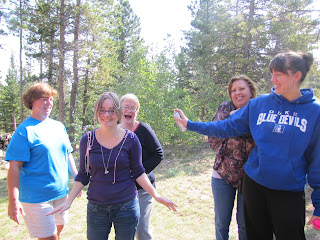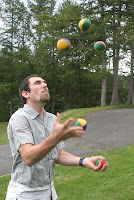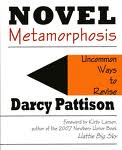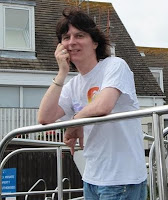Earlier this week, while I proofread a few chapters from my current WIP, a scary thought raced through my mind.
'It's so....white.'
Translated, it's completely vanilla and filled with cream-colored references. Even the main female character is decked out in white in almost every scene. (And no, she is not a doctor, and trust me, she's no angel.)
Now, I'm not saying the writing is bad, it's just lacking color in these chapters.
Kind of disappointing coming from a writer with "Mango Crush" on her office walls.
But the revelation reminded me of an exercise I would use with freshman English students who struggled to bring color to their writing.
Perhaps I'd asked them to describe the sun, bring it to life through color. What would I get? Yellow. Plain ol' yellow.
I would ask them to describe the shade of yellow. Is it the color of butter? Of a buttercup along a country road? The yellow of a middle-of-July sunflower? Post-it note yellow?
"Just yellow," students would reply.
The next day, they would be in for a surprise. Paint samples littered a tabletop. (Thank you, locally-owned hardware store.)
"Show me what kind of yellow."
Once they saw the connection between a concrete example and word choice, their writing improved.
I don't want my writing to be 'just yellow' - or just plain ol' white - for that matter. I want vibrant words to run down the pages.
After a trip to the lumber yard, Eros Pink, Adriatic Sea, and Jargon Jade complete the scenes, along with a tinge of Crescent Moon White.
by LuAnn Schindler. Read more of LuAnn's work at her website.

When I found out the awesome and talented
Melinda Collins was headed off to Colorado to attend
Margie Lawson's Immersion Master Class, I absolutely
had to convince her to swing by and tell us about the experience afterward. Of course, Writing Superhero
Jami Gold had the same idea, so rather than stage an EPIC,
lightning-sword-and-killer-unicorn BATTLE TO THE DEATH as to who got Melinda, we decided to share her. Isn't that nice? *beams*
As someone who purchased a
Margie Lawson Lesson Packet on Body Language (thanks for the heads up,
Stina Lindenblatt!) in the past, I can only imagine the value of a ML Intensive. So please, read on dear Musers. It's a long-ish post, but oh-so-worth it.
AND, the talented Margie Lawson is going to award a lucky commenter with a FREE Lecture Packet! Trust me, YOU WANT THIS.
Immersion Master Class with Margie Lawson: The Experience, The Takeaways, The Lessons – Part Two
Thank you, Angela, for inviting me over today to talk about my recent experience in Colorado with the wonderful, talented, writerly genius,
Margie Lawson, and her
Immersion Master Class!
Because I have so much to share, this is actually a two-part blog post. Which means I’m also over at
Jami Gold’s blog today as well with part one! *grin* And, as an added bonus, Margie Lawson will be over at my blog today,
Muse, Rant, Rave, sharing even more writing technique goodies! *booty dance* Okay, enough dancin’ and let’s get to learnin’, shall we?
The Experience
Over on Jami’s blog I talked about the kinship and sisterhood that developed in our group. Here I’d like to share with you two additional elements of the class that made this a one-of-a-kind experience.
The first would be location, location, location! We were about two miles above sea level, and being that high meant cell service was practically nonexistent, which in turn meant we got to enjoy the peace and quiet tranquility of the Rocky Mountains. What more inspiration do you need if you look outside the window, or go on a short hike and see this?
 |
| The view from our 1st hiking trip |
Pretty unreal, right? But this is
exactly what every day was like for us. It wasn’t
all work and no play. In fact, we went hiking twice during our time on the mountain. The first short hike gave us the beautiful view in the picture above, and the second, longer hike, gave us this gorgeous view:
 |
| The view from our 2nd hiking trip |
So the experience was deeper than just learning more about yourself and your writing craft. It was about taking the time to enjoy your surroundings and find inspiration in nature.
 |
| The view from Margie's writing loft |
The second element I wanted to share about the experience is the one on one time each of us got to spend with Margie. Every day, with pages in hand, we walked into a quiet, cozy room and worked one on one with Margie – an experience that will stay with me forever. By sitting down with her, one on one, you gain a certain understanding and perspective of your writing. You learn how to channel the genius editing that is her mind, and you see your writing in a whole new light. Every sentence, every word is purposefully chosen to pack a maximum punch for your reader, and during your one on one time, you learn more about how you choose those words and how you organize your sentences.
I can’t begin to imagine how I was editing before this class because now I feel as though I’m walking away with a particular sense of how to attack edits, how to look for the minor nuances, how to portray action scenes in a new and exciting way for the reader, and how to make my prose sing a beautifully cadenced tune.
The Takeaways
In part one I talk about what I learned about my style and where I want to be a year from now. Here I’d like to talk about group settings: why it’s important to work within a group where each person has the same purpose in their writing, and why it’s important to encourage and help other writers make their writing the best it can possibly be.
 |
| It's always important to take a break when editing to hike! ;) |
When you’re in a group setting and everyone has the same purpose of making their MS NYT Bestselling-worthy, you’re sitting in a gold mine. This is why it’s so incredibly important to join a writing group where everyone is dedicated and everyone pushes you to strive, work, and think harder. Sure, writing’s a singular experience (unless you’re co-writing), but without that group of writers who share your struggles, your doubts, and your triumphs, you may not get too far. This particular experience brought that fact home for me. When I struggled in making a phrase powerful and pitch-perfect, there were four other writers there tossing ideas back and forth until we got it. I’m sure without them there I might’ve gotten 85% of what I wanted in the phrase, but that’s not enough. I want 100%. I want it to pack a punch. And I want the help of other writers who fill in the gaps of my weaknesses.
This is another reason why it’s important to not only be in a group setting with a common purpose, but also to encourage other writers and their craft. We thrive on the encouragement and the kudos we get from others like us. We hear of another writer who’s just finaled
Individually, we are one drop. Together, we are an ocean. -- Ryunosuke Satoro
 |
| I got the honor of silly-stringing Amanda! Sooo much fun!!! :) |
Quick note: While we were there, one of our Immersion Sisters, Amanda, actually
did find out that she finaled in a writing contest with three scores of 99 out of 100!!!!! WOO HOO! How AWESOME is that?!? So what did we do to celebrate when we found out? We silly-stringed her of course!!!
The Lessons
Without giving away too much, here’s the back half of the top ten lessons I learned while in Colorado (as I said in the first post, there are many, many, many more):
1. Description: Description shouldn’t be on the page simply just to be there. Description should be on the page as it affects the character. When you’re writing description, think of how it affects your character in terms of their attitude and thoughts. If you had a character pull up to their childhood home, don’t just describe it as having paint-chipped shutters and a bright red door. Attach that description to your character. What does she remember about those shutters and that red door? Does she recall the many summers she spent helping her mother repaint the shutters? Does she recall being caught kissing a boy in front of the bright red door? If so, then why don’t you attach that description to those memories and make it a stronger, more powerful read?
Example from my MS:
I took a breath and walked out to the edge of the street. This house would represent the beginning of the rest of my life. I hadn’t seen the midnight blue, oceanfront home in so long, and it was now my home.
Because a home is a sense of trust, safety and love for my MC, I attached those feelings to the description of a place that is now
her home. There’s more description of the house that follows this, but this is the one place where I purposefully showed how arriving to this setting affected my character.
2. Breaking Tension: Margie has an EDITS system that uses different colored highlighters to track story elements. One is tension. When you’re tracking tension and you notice a small – or big – area where you’ve broken the tension, you’d better go back to check the following:
a.
Check to ensure you intended to break the tension. b.
Check to ensure the break in tension is not only needed, but that it works c.
Check to ensure it doesn’t entice the reader to skimI’m willing to bet there may be several areas where you didn’t intend to break the tension, you didn’t intend to invite the reader to skim, you didn’t intend to put a humor hit in the middle of a serious scene that shouldn’t be broken.
So if you break tension, make sure it’s intentional, it works, it flows, and it doesn’t bore the reader in skipping ahead to where the tension picks back up.
3. NO ‘ITs’ or ‘THATs’: I now have yet another new item to add to my editing toolbox/checklist: NO ‘ITs’ or ‘THATs’!! Okay, so obviously I don’t mean you can’t have ‘it’ or ‘that’ in your MS as at all. But what I do mean is don’t end a sentence with ‘it’ or ‘that.’
Example:
Oh yeah, I’d considered that. See what I mean? When I take this sentence out of context, you have absolutely no clue what the character meant by ‘that.’
Example without ‘that’:
Oh yeah, I’d considered Nick to be nothing more than an ant.A-ha! So when I removed ‘that,’ I made the sentence
stronger and
more powerful! So the lesson here is: do a find for ‘IT’ and ‘THAT’ and restructure/reword each sentence/phrase that just so happens to end with one of those UNLESS having one of those two words 100%, unequivocally works!
 4. Throw-Away Words (Tightening):
4. Throw-Away Words (Tightening): Another important item to add to your editing checklist: throw-away words. This goes beyond the usual crutch words such as saw, felt, was, etc. Once of the techniques Margie teaches is taking a printed copy of your MS and reading through, line by line, and checking each line off to ensure it has a strong cadence. This ensures you don’t have any words in there that might trip the reader or the flow of the passage. As we all know, there are many other types of throw-away words that can tongue-tie the reader – which is another reason why it’s incredibly important that we get used to the sound of our voice, read
everything aloud, and tighten, tighten, tighten.
Examples with Throw-Away Words:
After all, it wasn’t my fault their stories weren’t being told anymore. I looked back at where he stood and touched my cheek. Did I really need all those words? Nope.
Examples without Throw-Away Words:
It wasn’t my fault their stories weren’t being told anymore.I touched my cheek. See? I didn’t need
after all and
looked. Those were just two sentences! And between the two, I cut a total of
nine words! By reading through my MS, line by line by line, and checking each one off once I’ve determined it’s a TEN, I will have a MS that’s tight, tight, tight! *booty dance*
5. Backloading: Ah… this is a fun one! But because there’s so much I could say about it and so little space in today’s post, I’m going to make it short and sweet. Backloading is where you take the most powerful word in a sentence, and you rework the phrase to pack that power at the
end of the sentence so it resonates with the reader.
Example before Backloading:
And when we did see him, we never took a moment for granted, but that was before he abandoned us. The most powerful word in this particular phrase is
abandoned. When you hear it, you instantly feel for the character because you may know what it’s like to feel abandoned. So why not make it the last word the reader processes before they move to the next paragraph?
Example after Backloading:
And when we did see him, we never took a moment for granted. But that was before we were abandoned. Not only did I ensure my power word was there to backload the phrase, I also split that large phrase into one semi-big sentence then followed it up with a shorter, powerful sentence.
Backloading forces you to look at the structure of your sentences and paragraph breaks. By examining each sentence with a finely-tuned, analytical eye, you’ll not only catch the instances where backloading will pack a punch, but you’ll also catch the areas where one larger sentence can be broken into two, shorter, more powerful sentences. Ha! I got two lessons into one on that one! *giggle*
Once again, I really, really, really want to encourage everyone to visit
Margie’s site, purchase and read and
absorb the lecture packets and/or enroll in an online course. After you’ve done that, I really recommend attending an
Immersion Master Class yourself to fully learn not only these techniques/lessons, but waaaaay more! In all her courses, you’ll learn ways to add psychological power to your writing and how to write a page-turner that will keep your readers up until their spouse finally says, “Pleeeease come to bed!” *giggle*
Before I go, I just want to say thank you again to Angela for having me over today and allowing me to share a small percentage of what I learned!
If this was your first stop, then before you pop over to either Jami’s site for
more on the experience, the takeaways and the lessons, or
stop by my blog for a quick lesson from Margie, think about the following: Do you have a place you can get away to? One that’s quiet, calm and inspiring? What about a writing group – do you have a group of writers that you can learn from, give kudos to, and share your triumphs with? Do you have areas in your MS that could benefit from tying description to emotion? Or what about areas where you’ve broken the tension unintentionally? Do you run through each of your lines and ensure they work 100% before moving onto the next?
 Wow!
Wow! Thank you
Melinda for being so generous and sharing your amazing experience with Margie! I am a life-long learner, and I absolutely love to absorb as much as I can about the writing craft. Margie's lecture packets are packed with great information and I am
thrilled to be able to give one away.
So, if you would like to win, just comment below and leave some contact information. THEN, visit
Jami for
another chance to win a
lecture packet and
Melinda's for a crack at an
online course with Margie! This is the
BERMUDA TRIANGLE OF WIN,
people!Good luck & happy writing!
Today, a treat! Dr. John Yeoman joins us from
Writers' Village, a blog dedicated to helping writers succeed. Holding a PhD in Creative Writing, John is the author of eight humour books, tutors at a UK University and judges for the Writers’ Village story competition. If you like, he offers a free 14-part course in writing fiction for profit on his
website. If you've ever been interested in entering writing contests, this site might be a good starting point, especially for UK writers.
Now I'll turn things over to him, so read on!
~ ~ ~
Want to Write a Best Seller? Change Your Mind!
Teenagers know better than we do, how to write great stories. Sounds absurd? We’re experienced authors, right? We know the craft tricks. We’ve pounded the keypad all our lives...
Yet, it’s true. Because young people often have a freshness of experience that we can’t match. Simply, they don’t know enough as yet. And that’s their gift.
Of course, they might not be great shakes at grammar or punctuation. That’s dog work. It’s quickly learned. What they have, most of them, is a freshness of perception. And we can’t match it.
Perhaps we had it once. Then we lost it, around the time our teacher slapped us down for telling lies. Or we set our hearts on some literal-minded discipline like chemistry or bricklaying.
But maybe it’s still there, whimpering at us like a child locked in a closet. If we’re creative writers, we can hear it...
To see the world as it is, without labels, is the gift of genius. Maybe William Blake had it. For him, to describe a tree as an angel was not just a metaphor. He actually saw an angel.
Hemingway had a similar gift. He didn’t see angels, of course. He saw the bedrock of experience, stripped of its metaphors. He found the words to describe what he saw. Then he stripped off a thousand superfluous words for every word he used.
Can we find that freshness in our own writing?
Sometimes. There’s a trick to it. I teach creative writing at a UK university. As an exercise, I ask my first-year students to wander around the campus for 20 minutes. Stop at random, I say. Just stop for five minutes and look at what’s in front of you. (Be discreet, I tell them...)
Pretend you have never seen that thing before. Use all your five senses to perceive it. Then come back and write a few lines to describe what you perceived.
I tell them: “You can’t just write: ‘I saw a mop propped in a bucket.’” That’s journalism. Bring out the essence of that mop.
Some students ‘get’ it.
“The mop gazed at me like an old man with a grey beard and rheumy eyes.” “The garbage bin was an Aztec god. Cigarette butts lay around it, ritual offerings.” “Parked cars steamed in the forecourt. Beetles with bright carapaces. Roaches stained with rust. Everywhere, the tangled antennae of bicycles.”
Annie Proulx does this in
The Shipping Forecast. Every line glows with epiphanies. Maybe she does it too much. The book screams: “Look at me. Don’t I write well?” David Lindsey gets it right in
A Cold Mind. Among the routine squalor of a murder hunt, Lindsey hits us
 |
| Click for the recipe! |
Hi everyone, I have SUCH a treat today! Some of my very good friends and writers that I greatly admire are releasing a short story collection,
Sweeter Than Tea through Belle Books. When I found out I was all,
Ahhh! and jumping around and stuff, and then I calmed down enough to ask if they might stop by and share with us a powerful
Description Tip.
Many of the authors were able to be here today with Becca and I, and their tips follow. But that's not all.
Belle Books is offering up 10 (yes, T-E-N) print copies of this southern-flavored collection for you to WIN. How delicious is that? So read on and check out these excellent tidbits, and
leave us a comment if you'd like to be included in the giveaway. Descriptive Tips To Give Your Writing A Boost
Kathleen Hodges: There's so much we want to tell our readers when we start a book so they understand our characters and their lives that we often fill the early chapters of the story with tons of backstory. After I wrote my first book, filled with purple prose and pages of backstory, I was lucky enough to have an experienced published writer look at it. She pointed to spot around page 62 in Chapter Three, and said, "Here's your beginning." And that started a writing exercise I used with most of my books after that. I would just write to my heart's content, not worrying about anything except building my characters, and the beginning would find me. Then I would take the key elements of those beginning pages and filter them in slowly. Getting that backstory out of my system was essential to knowing my characters, but not necessarily essential for my reader.
Visit Kathleen at A Writer's House!Martina Boone: When creating a setting or a character, put in one main, memorable detail that simultaneously builds-in active interaction opportunities. Incorporate that detail into the scene or story through action. Use it to show emotion. For example, the framed photo that a character smashes can tell us a lot about that character. What was the photo? When was it taken? What does it represent? How is it framed—in gold, in plain, cheap wood? Where was it kept in the room—among a lot of other photos on the mantel, at the back of a collection on the end table, by itself in pride of place? Choosing how you describe something forces you to concentrate on coming up with something meaningful and makes your description further your story as well as paint a visual.
Visit Martina at Adventures in YA & Children's Publishing!Deborah Grace Staley: Trust that you know enough to write well. Don't get me wrong. You have to do the work. Read novels like a writer, finding something in that author's writer's toolbox that you might need in yours. Go to seminars and conferences to learn about the craft from professionals. Or take a class. But at some point, acknowledge that you know something, too. Enough to see you through writing the book. Trust yourself and your instincts. Most of all, trust that when you sit down to write, even if






























LuAnn-
I've used those paint samples that I've borrowed/snagged/stolen from hardware stores, punched a hole in each of them, and put them on a round key ring, so they're handy for kids to use.
Yes, "vanilla" is fine, but we wouldn't want to live on an entire diet of only vanilla ice cream, white bread, and mashed potatoes. We need strawberry and chocolate syrup, we need a layer of melted cheddar cheese, we need a brown gravy speckled with pepper to make it appealing.
Good luck adding color to your WIP, LuAnn...
Great reminder! Like the way you have used paint chips !
Great writing idea--I think it would work for adult writers, too in a writing workshop.
I always tell writers not to put too many colors in though OR then readers almost become overwhelmed with the colors they are trying to imagine. Everything with writing is such a fine line. :)
At least it was white and not Fifty Shades of Grey. ;)
A great reminder, and superbly handled. I feel confident your students were blessed! Thanks for sharing --
Oh my god thank you. I have a giant collection of paint samples to help me with colour and people always think I'm crazy.